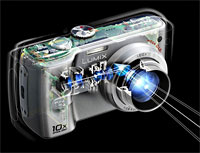 Panasonic have released two additions to their popular Lumix digital camera range which the company are claiming are the world’s smallest in their categories.
Panasonic have released two additions to their popular Lumix digital camera range which the company are claiming are the world’s smallest in their categories.
The Lumix DMC-TZ1 is being touted as the world’s smallest 10x optical zoom digital compact, while the equally diminutive Lumix DMC-FX01 claims the honours as the smallest digital compact with a 28mm wide-angle lens.
Lumix DMC-TZ1
Billed as “the ultimate travelling companion”, the DMC-TZ1 uses a cunning optical system using folded optics, a retractable lens system and a prism to offer the immense 10x zoom range (35-350mm equiv, F2.8-5.0).
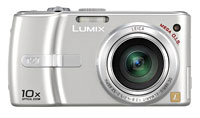 The 5 megapixel camera comes with Panasonic’s well regarded optical image stabilisation system (you’ll definitely need that at the far end of its monster zoom) and sports the newly developed Venus Engine III, offering quick response times and an improved battery life (250 shots).
The 5 megapixel camera comes with Panasonic’s well regarded optical image stabilisation system (you’ll definitely need that at the far end of its monster zoom) and sports the newly developed Venus Engine III, offering quick response times and an improved battery life (250 shots).
The Lumix looks to be faster than grit off a shovel with its new Linear AF system claiming an industry-leading high speed AF performance, with the makers boasting a super-nippy shutter release time of 0.006sec minimum, a shutter interval of approximately 0.5 seconds and up to three frames per second in full resolution.
 After the dire high ISO performance of the Lumix flagship model, the LX1, we were happy to see the new Venus Engine III claiming to “dramatically reduce noise levels at increased ISO settings”, with ISO selectable from ISO80 to ISO800 (with a High Sensitivity Mode from ISO 800-1600).
After the dire high ISO performance of the Lumix flagship model, the LX1, we were happy to see the new Venus Engine III claiming to “dramatically reduce noise levels at increased ISO settings”, with ISO selectable from ISO80 to ISO800 (with a High Sensitivity Mode from ISO 800-1600).
Like the LX1, the TZ1 can record widescreen movies at 848 x 480 (and 640 x 480) at 30 fps with sound and comes with zillions of scene modes but no manual mode.
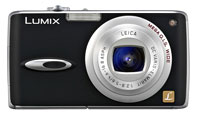 There’s also 13.4 MB of internal memory onboard, a SD/MMC card slot and a 2.5-inch, 207k pixel TFT LCD.
There’s also 13.4 MB of internal memory onboard, a SD/MMC card slot and a 2.5-inch, 207k pixel TFT LCD.
The camera is expected to be in the shops in March for $349.95 (~£207, ~€294).
Lumix DMC-FX01
The successor to the DMC-FX9, the new 6-megapixel Lumix DMC-FX01 is another petite chappie, boasting an impressively wide 28mm Leica DC zoom lens.
The FX01 incorporates the Venus Engine Plus LSI, offering 320 pictures on a single charge, a 1.6 second start up time (20% less than the DMC-FX9) and a 0.005 second shutter lag.
The new High Sensitivity mode allows low light shooting up to ISO 1600, with the built in Optical Image Stabiliser keeping the shakes at bay.
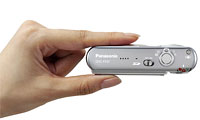 The f/2.8, Leica zoom lens gives users a handy wideangle range of 28-102mm equiv., and the camera come with the usual smorgasbord of scene modes for every conceivable occasion.
The f/2.8, Leica zoom lens gives users a handy wideangle range of 28-102mm equiv., and the camera come with the usual smorgasbord of scene modes for every conceivable occasion.
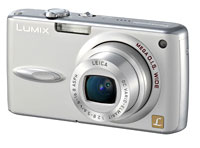 The camera is also expected to be out in March for $349.95.
The camera is also expected to be out in March for $349.95.
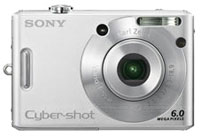 Ahead of the big PMA (Photo Marketing Association International) show at the end of the month in Florida, Sony has announced two new 6-megapixel cameras in their ‘W’ range.
Ahead of the big PMA (Photo Marketing Association International) show at the end of the month in Florida, Sony has announced two new 6-megapixel cameras in their ‘W’ range.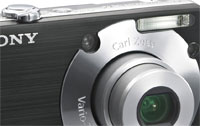 Looking somewhat reminiscent of the Canon Ixus / Elph range, the miniaturised, re-engineered W-series offers a compact, highly pocketable design (89x59x23mm) with a price that’s easy on the pocket too, with the DSC-W30 retailing for $230 (~£132, ~e193) and the DSC-W50 for $250 (~£143, ~e209).
Looking somewhat reminiscent of the Canon Ixus / Elph range, the miniaturised, re-engineered W-series offers a compact, highly pocketable design (89x59x23mm) with a price that’s easy on the pocket too, with the DSC-W30 retailing for $230 (~£132, ~e193) and the DSC-W50 for $250 (~£143, ~e209).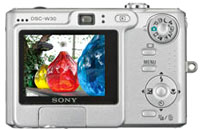 At higher ISO ratings noise can become a real issue, but Sony are claiming that their Clear RAW imaging technology keeps the multi-colour snow-storm effect to a minimum.
At higher ISO ratings noise can become a real issue, but Sony are claiming that their Clear RAW imaging technology keeps the multi-colour snow-storm effect to a minimum.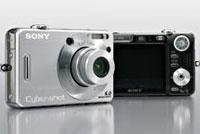 To help fumbling newbies and the easily baffled, Sony has added a new function guide which displays a short onscreen text explanation whenever a shooting mode is selected. This can be turned off once the user becomes familiar with the icons on the mode dial.
To help fumbling newbies and the easily baffled, Sony has added a new function guide which displays a short onscreen text explanation whenever a shooting mode is selected. This can be turned off once the user becomes familiar with the icons on the mode dial. Scene modes Twilight, Twilight Portrait,Landscape,Beach,Snow,Soft Snap
Scene modes Twilight, Twilight Portrait,Landscape,Beach,Snow,Soft Snap For the second time in a fortnight, coastguards have been scrambled after a digital TV box sent out a signal on a wavelength used by ships in distress.
For the second time in a fortnight, coastguards have been scrambled after a digital TV box sent out a signal on a wavelength used by ships in distress.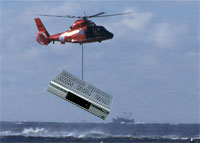 An Ofcom spokesman explained that the faulty boxes are now being examined for malfunctioning components, adding: “Apparently any device capable of receiving a signal can also send a signal if it malfunctions. To the best of our knowledge these are the only two out of millions of Freeview users in the UK to have experienced this problem.”
An Ofcom spokesman explained that the faulty boxes are now being examined for malfunctioning components, adding: “Apparently any device capable of receiving a signal can also send a signal if it malfunctions. To the best of our knowledge these are the only two out of millions of Freeview users in the UK to have experienced this problem.” They’ve been busy boys at BT this week, with the UK telecoms giant making two major announcements.
They’ve been busy boys at BT this week, with the UK telecoms giant making two major announcements. Using the UK’s existing digital audio broadcasting (DAB) network, the broadcast service will be offered on a limited exclusive basis to virgin Mobile customers later this year. BT Movio will be available in the future to all mobile operators in the UK.
Using the UK’s existing digital audio broadcasting (DAB) network, the broadcast service will be offered on a limited exclusive basis to virgin Mobile customers later this year. BT Movio will be available in the future to all mobile operators in the UK.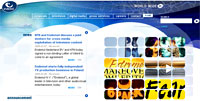 Microsoft partnership
Microsoft partnership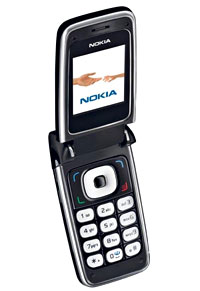 Launched at the 3GSM World Congress in Barcelona, Nokia’s new 6136 phone is being touted as the handset that brings GSM and wireless LANs together.
Launched at the 3GSM World Congress in Barcelona, Nokia’s new 6136 phone is being touted as the handset that brings GSM and wireless LANs together.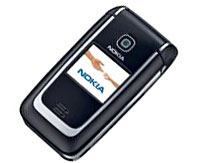 The quad-band Nokia 6136 will be able to connect to GSM networks at 850, 900, 1800, and 1900MHz (so no problems using it in the States as well as Europe) and comes with a built in 1.3 megapixel camera and FM radio.
The quad-band Nokia 6136 will be able to connect to GSM networks at 850, 900, 1800, and 1900MHz (so no problems using it in the States as well as Europe) and comes with a built in 1.3 megapixel camera and FM radio.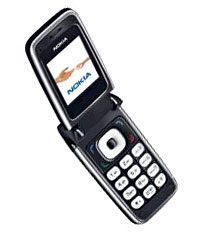 At a press conference on Monday, Jorma Ollila, Nokia’s chief executive said, “We want to help our customers complement their existing mobile services with mobile IP. UMA gives users an alternative to PC-based VoIP,”
At a press conference on Monday, Jorma Ollila, Nokia’s chief executive said, “We want to help our customers complement their existing mobile services with mobile IP. UMA gives users an alternative to PC-based VoIP,” Anyone who’s anyone in the 3GSM world will be hot footing it to the 3GSM World Congress in Barcelona, which starts tomorrow.
Anyone who’s anyone in the 3GSM world will be hot footing it to the 3GSM World Congress in Barcelona, which starts tomorrow. The mobile phone industry is desperate to come up with mass market services to entice consumers to use 3G networks, but they’ve got their work cut out, with a recent survey finding that almost 80 per cent of UK users said that mobile services are getting too complicated.
The mobile phone industry is desperate to come up with mass market services to entice consumers to use 3G networks, but they’ve got their work cut out, with a recent survey finding that almost 80 per cent of UK users said that mobile services are getting too complicated. BT are also going to be at the show and are expected to launch their new broadcast digital TV to mobile service,
BT are also going to be at the show and are expected to launch their new broadcast digital TV to mobile service,  Major UK consumer broadband providers NTL are teaming up with BitTorrent, the developers of the world’s most popular peer-to-peer (P2P) application.
Major UK consumer broadband providers NTL are teaming up with BitTorrent, the developers of the world’s most popular peer-to-peer (P2P) application. Naturally, rights holders and movie heavyweights weren’t too chuffed to see their content whizzing around the Internet for gratis, and quickly hired in squadrons of lawyers to apply pressure on BitTorrent.
Naturally, rights holders and movie heavyweights weren’t too chuffed to see their content whizzing around the Internet for gratis, and quickly hired in squadrons of lawyers to apply pressure on BitTorrent. According to a new report, future growth in the Japanese mobile market is to be focused on the only market segment yet to reach 100% saturation: the under 14s and over 55s.
According to a new report, future growth in the Japanese mobile market is to be focused on the only market segment yet to reach 100% saturation: the under 14s and over 55s. The biggest growth, however, comes from the 55-65 age group, with 1.62 million new customers expected in 2006.
The biggest growth, however, comes from the 55-65 age group, with 1.62 million new customers expected in 2006. Blended ARPU is expected to continue sliding from $58 pcm in 2005 to $57 pcm by 2007 but this should be compensated by data ARPU which is predicted to rise from $15 pcm to $17 pcm over the same period, thanks to the growth of content market.
Blended ARPU is expected to continue sliding from $58 pcm in 2005 to $57 pcm by 2007 but this should be compensated by data ARPU which is predicted to rise from $15 pcm to $17 pcm over the same period, thanks to the growth of content market. Wikinews, the collaborative online journalism project spawned from Wikipedia, has been digging up more dirt on the Wikipedia edits made by Capitol Hill staffers.
Wikinews, the collaborative online journalism project spawned from Wikipedia, has been digging up more dirt on the Wikipedia edits made by Capitol Hill staffers. Hot on their trail, the meticulous volunteers at Wikinews collected every Senate IP which had ever been edited on Wikipedia (up to February 3) and examined where the IPs came, what was edited and what the edits comprised of.
Hot on their trail, the meticulous volunteers at Wikinews collected every Senate IP which had ever been edited on Wikipedia (up to February 3) and examined where the IPs came, what was edited and what the edits comprised of. Open, collaborative information projects like Wikipedia and Wikinews have been welcomed by Internet activists keen to make unbiased information freely available, but the very nature of the project makes it wide open to abuse (as one pundit commented, “The information on your screen may be only as good as the most recent users’ motives.”)
Open, collaborative information projects like Wikipedia and Wikinews have been welcomed by Internet activists keen to make unbiased information freely available, but the very nature of the project makes it wide open to abuse (as one pundit commented, “The information on your screen may be only as good as the most recent users’ motives.”) Keen to further expand their vice-like grip on the portable digital music market, Apple have unveiled a cut-down 1GB version of their turbo box-shifting iPod Nano player.
Keen to further expand their vice-like grip on the portable digital music market, Apple have unveiled a cut-down 1GB version of their turbo box-shifting iPod Nano player.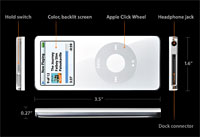 The new 1GB Nano can hold up to 240 songs or 15,000 photographs and comes with all the usual Nano features, including the colour display and docking connector.
The new 1GB Nano can hold up to 240 songs or 15,000 photographs and comes with all the usual Nano features, including the colour display and docking connector.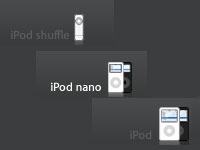 As Shaw Wu, an analyst with American Technology Research, put it: “Apple is selling a $69 MP3 player with the best software. How do you compete with that? It’s tough.”
As Shaw Wu, an analyst with American Technology Research, put it: “Apple is selling a $69 MP3 player with the best software. How do you compete with that? It’s tough.”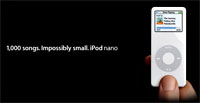 The iPod range continues to be an outrageously successful money spinner for Apple, with around 32 million iPods shifted last year, including 14 million during the holiday season.
The iPod range continues to be an outrageously successful money spinner for Apple, with around 32 million iPods shifted last year, including 14 million during the holiday season.